Modern Rainwater Harvesting Techniques Individuals & Societies Can Adopt
By: Muskan Aggarwal | Date: 16th August 2018
Read First Part of this Article: What Can We Learn From Traditional Indian Rainwater Harvesting Systems?
Now that we have gone through the traditional methods let us look at the modern techniques that have been adopted by both individuals and societies.
RAINWATER OVERHEAD TANKS

These are the simple tanks placed over the building or on the terrace, collecting water as it comes. Very expensive installation.
ROOFTOP RAINWATER HARVESTING
 Image Source: aplustopper
Image Source: aplustopper
A simple structure where the roof is used as a support for installing catchment pipes through which the rain water flows and is eventually stored in ground level containers for direct use or recharged into ground water.
FERRO-CEMENT TANKS
 Image Source: akvo.org
Image Source: akvo.org
This is a low-cost alternative for expensive water harvesting containers made of masonry, plastic and RCC. It has proved highly effective in high rainfall regions where large amount of water needs to be stored in clean form.
These tanks requiring materials like sand, cement, mild steel bar and galvanized iron wire mesh, can be easily constructed by semi-skilled labours. It’s light in weight and can be moulded into any shape required. It is believed to last for around 25 years with little maintenance.
RAIN WATER SYRINGE
 Image Source: ecoideaz
Image Source: ecoideaz
Most of the open wells and tube wells in coastal areas contain salty water due to seepage of sea water. Rainwater harvesting is a viable option for solving the issue of drinking water, but construction of rainwater overhead tanks is unaffordable for marginal farmers.
Antoji in Kerala has innovated a cost-effective method for harvesting rainwater in coastal areas. Rainwater is collected from the roof tops of houses and stored in a pressure tank on the ground and with the help of PVC pipes, water is lowered below sea level (16-24 feet).
The water is retained in the underground water column which is then harvested during summer by a simple piston pump or motor by constructing a tube well in the vicinity. It has proved successful in diluting recharging ground water in coastal areas of Kerela and Antoji has installed 150 tanks in different parts of Kerala.
GROUND WATER DAMS
 Image Source: mavensnotebook
Image Source: mavensnotebook
This method of rainwater harvesting is used majorly in places where the underground water level varies. A dam is constructed underground to obstruct the flow of underground water and create a reservoir to store water.
During the rains, the water percolates from the surface and reaches these underground reservoirs, increasing the water level by a considerable amount. The main advantage of these underground reservoirs is that the water is not polluted by the contaminants in the air. Also, the water stored underground does not reduce by way of evaporation.
Now that we have looked at both the traditional and modern techniques of RWH we should compare the both of them.
One sure shot comparison is that despite technological advancement and existence of seemingly fool proof modern systems, the problem of water shortage in India has not been solved, whereas the ancient and medieval societies found themselves self-sufficient.
There are various reasons which can explain the contrast as the conditions of those societies were different from our present day, like:
- 1. The exponential increase in population growth over the centuries.
- 2. The adverse change in climate and its deterioration.
But does that mean that nothing can be done to bridge the gap?
The answer is no.
One needs to realise that the modern techniques involve heave installation costs which might not be possible for everyone except the wealthy to cover.
What we can do is look at the various techniques and devise plans which can integrate the modern and traditional techniques (finding a mid-way) like ferro-cement tanks, which will increase the productivity with facilitation of technology and with the success rates of traditional methods, thus producing both cost-efficiency and cost-effective implementation (battling the high rates of investment as well), thereby also allowing every section of society to participate or contribute in RWH without a second thought.
It may be a utopian perspective but if experts work on devising such techniques it may not be such a pipe dream. Thus, it is rightly said, ‘look into the past and you may find a solution to the problems of today.












